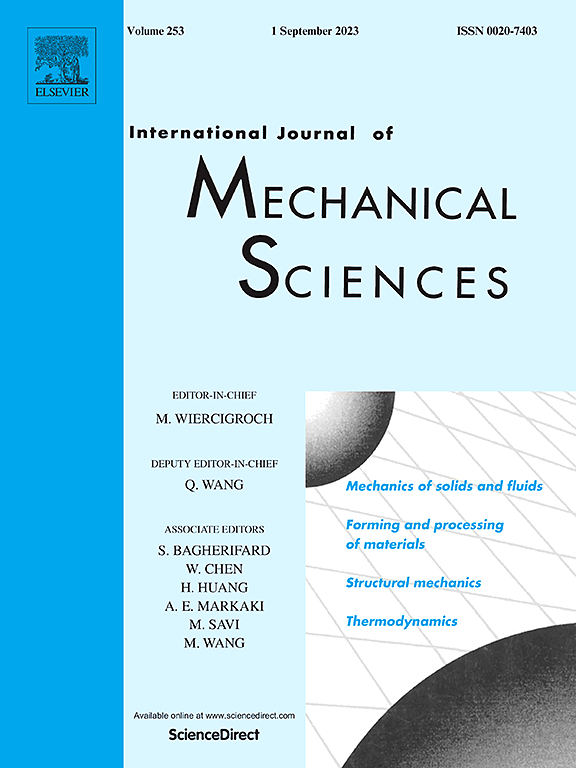Negative stiffness mechanical metamaterial with controllably programmable bandgaps
IF 7.1
1区 工程技术
Q1 ENGINEERING, MECHANICAL
International Journal of Mechanical Sciences
Pub Date : 2025-07-20
DOI:10.1016/j.ijmecsci.2025.110614
引用次数: 0
Abstract
Materials with wide bandgap distributions have significant potential in the development of novel vibration isolation and damping systems, especially for aerospace and automotive applications. Three mechanical metamaterials were proposed, consisting of negative stiffness elements, honeycomb structures, and resonators, with the negative stiffness elements fabricated from shape memory polymers. By integrating the tunability of smart materials and analyzing from the perspective of phononic crystals, the metamaterials exhibit programmable and highly tunable bandgap properties. The results show that the configuration of negative stiffness elements directly affects the equivalent stiffness of the metamaterial, thereby altering its dispersion relation and transmission properties. The impact of geometric parameters on the modulation of bandgap frequency and transmission properties is systematically verified. Furthermore, two reversible methods, shape memory shape programming and stiffness programming are proposed. The highly nonlinear and impedance mismatch characteristics of the programming structures enable bandgap adjustment under complex loading conditions, achieving full-band vibration isolation within the 1000Hz frequency range. Additionally, interfaces with different gradients can accurately control the transmission and blocking of excitation frequencies. Programmable coordination based on mechanical pixels ensures the integration of negative stiffness mechanical metamaterials in high precision devices.具有可控可编程带隙的负刚度机械超材料
具有宽禁带分布的材料在开发新型隔振和阻尼系统方面具有巨大的潜力,特别是在航空航天和汽车应用方面。提出了由负刚度单元、蜂窝结构和谐振腔组成的三种机械超材料,其中负刚度单元由形状记忆聚合物制备。通过整合智能材料的可调性,从声子晶体的角度分析,该超材料具有可编程和高度可调谐的带隙特性。结果表明,负刚度单元的构型直接影响了超材料的等效刚度,从而改变了其色散关系和透射特性。系统地验证了几何参数对带隙频率调制和传输特性的影响。在此基础上,提出了形状记忆、形状规划和刚度规划两种可逆方法。编程结构的高度非线性和阻抗失配特性使其能够在复杂负载条件下进行带隙调整,从而在1000Hz频率范围内实现全频带隔振。此外,不同梯度的界面可以精确控制激励频率的传输和阻断。基于机械像素的可编程协调保证了负刚度机械超材料在高精度器件中的集成。
本文章由计算机程序翻译,如有差异,请以英文原文为准。
求助全文
约1分钟内获得全文
求助全文
来源期刊

International Journal of Mechanical Sciences
工程技术-工程:机械
CiteScore
12.80
自引率
17.80%
发文量
769
审稿时长
19 days
期刊介绍:
The International Journal of Mechanical Sciences (IJMS) serves as a global platform for the publication and dissemination of original research that contributes to a deeper scientific understanding of the fundamental disciplines within mechanical, civil, and material engineering.
The primary focus of IJMS is to showcase innovative and ground-breaking work that utilizes analytical and computational modeling techniques, such as Finite Element Method (FEM), Boundary Element Method (BEM), and mesh-free methods, among others. These modeling methods are applied to diverse fields including rigid-body mechanics (e.g., dynamics, vibration, stability), structural mechanics, metal forming, advanced materials (e.g., metals, composites, cellular, smart) behavior and applications, impact mechanics, strain localization, and other nonlinear effects (e.g., large deflections, plasticity, fracture).
Additionally, IJMS covers the realms of fluid mechanics (both external and internal flows), tribology, thermodynamics, and materials processing. These subjects collectively form the core of the journal's content.
In summary, IJMS provides a prestigious platform for researchers to present their original contributions, shedding light on analytical and computational modeling methods in various areas of mechanical engineering, as well as exploring the behavior and application of advanced materials, fluid mechanics, thermodynamics, and materials processing.
 求助内容:
求助内容: 应助结果提醒方式:
应助结果提醒方式:


